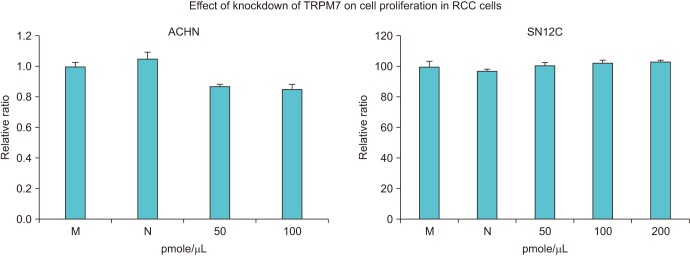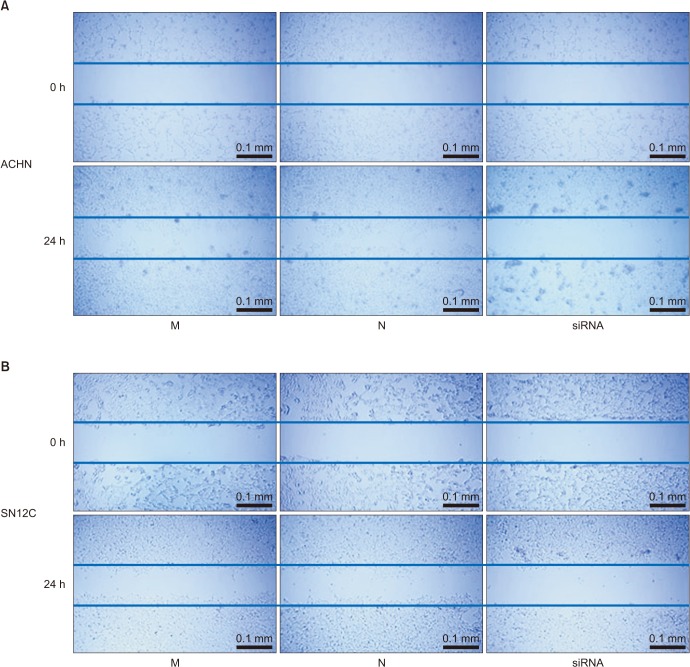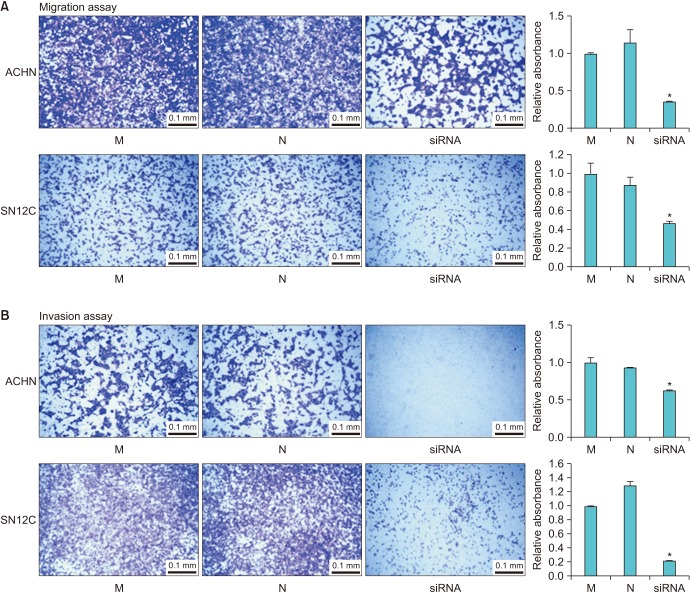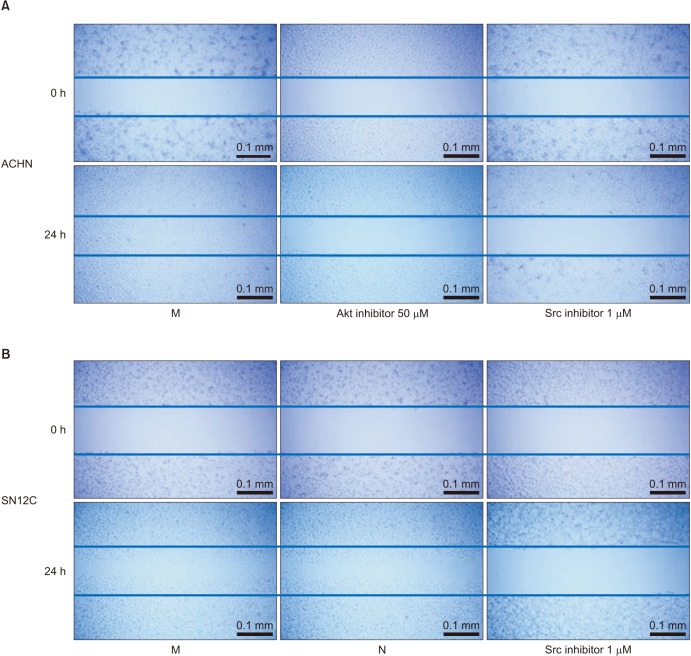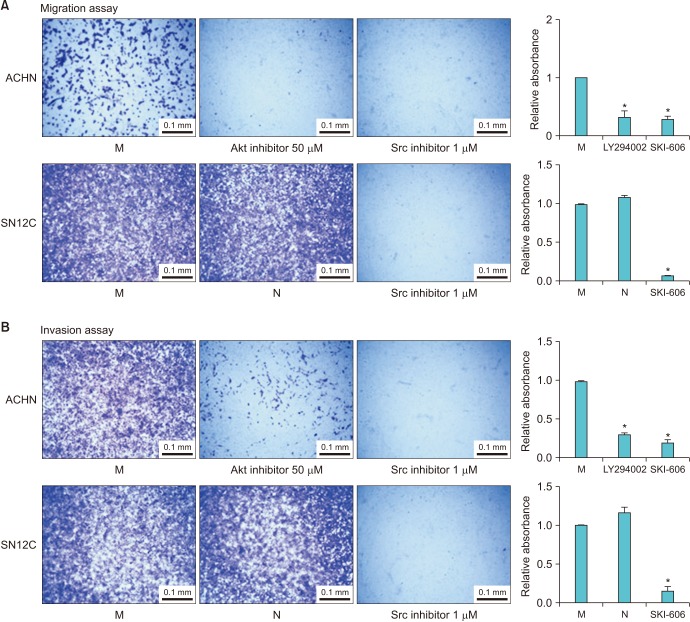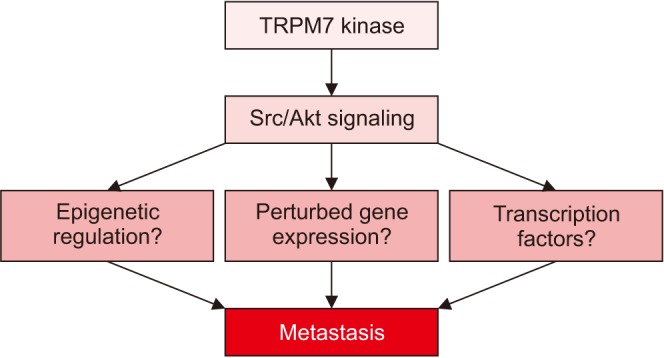Investig Clin Urol.
2018 Jul;59(4):263-274. 10.4111/icu.2018.59.4.263.
Down-regulation of transient receptor potential melastatin member 7 prevents migration and invasion of renal cell carcinoma cells via inactivation of the Src and Akt pathway
- Affiliations
-
- 1Department of Urology, School of Medicine, Kyungpook National University, Daegu, Korea. tgkwon@knu.ac.kr
- 2Department of Urology, Kyungpook National University Hospital, Daegu, Korea.
- 3Department of Pharmacology, Kyungpook National University School of Medicine, Daegu, Korea.
- 4Immunoregulatory Material Research Center, Korea Research Institute of Bioscience and Biotechnology (KRIBB), Jeongeup, Korea.
- KMID: 2414760
- DOI: http://doi.org/10.4111/icu.2018.59.4.263
Abstract
- PURPOSE
Transient receptor potential melastatin member 7 (TRPM7), an ion channel and serine/threonine protein kinase, has been linked with distinct human malignancies. However, the role of TRPM7 in renal cell carcinoma (RCC) has not been investigated. The aim of this study is to determine whether TRPM7 regulates the migration and invasion of RCC cells. Its relationship with signal transduction pathways was also studied.
MATERIALS AND METHODS
The human RCC cell lines ACHN and SN12C were chosen for this study. The molecular mechanisms of TRPM7 action were studied using Western blot analysis and small interfering RNA (siRNA)-based knockdown. The effect of TRPM7 knockdown on RCC cells was measured by using Transwell invasion and wound healing migration assays.
RESULTS
siRNA-induced silencing of TRPM7 notably decreased the migration and invasion of ACHN and SN12C RCC cells. The phosphorylation levels of Src in both cells were obviously reduced after TRPM7 silencing compared with that of the control ACHN and SN12C cells. Furthermore, the phosphorylation levels of Akt were greatly decreased in ACHN cells after siRNA-induced knockdown of TRPM7. Additionally, the treatment of cells with Src and Akt inhibitors clearly limited the migration and invasion of RCC cells.
CONCLUSIONS
Our data show that TRPM7 regulated ACHN and SN12C RCC cell invasion via the Src/Akt signaling pathway. Therefore, targeting the Src/Akt signaling pathway and/or the expression or function of TRPM7 could be a potential beneficial treatment for patients with RCC.
MeSH Terms
Figure
Reference
-
1. Siegel RL, Miller KD, Jemal A. Cancer statistics, 2017. CA Cancer J Clin. 2017; 67:7–30. PMID: 28055103.
Article2. Compérat E, Camparo P. Histological classification of malignant renal tumours at a time of major diagnostic and therapeutic changes. Diagn Interv Imaging. 2012; 93:221–231. PMID: 22465787.
Article3. Athar U, Gentile TC. Treatment options for metastatic renal cell carcinoma: a review. Can J Urol. 2008; 15:3954–3966. PMID: 18405442.4. Cohen HT, McGovern FJ. Renal-cell carcinoma. N Engl J Med. 2005; 353:2477–2490. PMID: 16339096.
Article5. Choi JY, Ko YH, Song PH. Clinical significance of preoperative thrombocytosis in patients who underwent radical nephrectomy for nonmetastatic renal cell carcinoma. Investig Clin Urol. 2016; 57:324–329.
Article6. Duensing S, Hohenfellner M. Adjuvant therapy for renal-cell carcinoma: settled for now. Lancet. 2016; 387:1973–1974. PMID: 26969091.
Article7. Gaudet R. A primer on ankyrin repeat function in TRP channels and beyond. Mol Biosyst. 2008; 4:372–379. PMID: 18414734.
Article8. Lehen'kyi V, Shapovalov G, Skryma R, Prevarskaya N. Ion channnels and transporters in cancer 5 Ion channels in control of cancer and cell apoptosis. Am J Physiol Cell Physiol. 2011; 301:C1281–C1289. PMID: 21940667.9. Runnels LW, Yue L, Clapham DE. TRP-PLIK, a bifunctional protein with kinase and ion channel activities. Science. 2001; 291:1043–1047. PMID: 11161216.
Article10. Ryazanova LV, Rondon LJ, Zierler S, Hu Z, Galli J, Yamaguchi TP, et al. TRPM7 is essential for Mg2+ homeostasis in mammals. Nat Commun. 2010; 1:109. PMID: 21045827.11. Latorre R, Zaelzer C, Brauchi S. Structure-functional intimacies of transient receptor potential channels. Q Rev Biophys. 2009; 42:201–246. PMID: 20025796.
Article13. Reis ST, Leite KR, Piovesan LF, Pontes-Junior J, Viana NI, Abe DK, et al. Increased expression of MMP-9 and IL-8 are correlated with poor prognosis of bladder cancer. BMC Urol. 2012; 12:18. PMID: 22695075.
Article14. Jung KW, Won YJ, Oh CM, Kong HJ, Lee DH, Lee KH. Prediction of cancer incidence and mortality in Korea, 2017. Cancer Res Treat. 2017; 49:306–312. PMID: 28301926.
Article15. Lee JN, Chun SY, Lee HJ, Ha YS, Kim HT, Yoo ES, et al. High Notch1 expression correlates with tumor stage and size in clear cell renal cell carcinoma. Korean J Urol Oncol. 2016; 14:130–137.
Article16. Wang J, Zhao X, Qi J, Yang C, Cheng H, Ren Y, et al. Eight proteins play critical roles in RCC with bone metastasis via mitochondrial dysfunction. Clin Exp Metastasis. 2015; 32:605–622. PMID: 26115722.
Article17. Cho YH, Kim MS, Chung HS, Hwang EC. Novel immunotherapy in metastatic renal cell carcinoma. Investig Clin Urol. 2017; 58:220–227.
Article18. Gupta GP, Massagué J. Cancer metastasis: building a framework. Cell. 2006; 127:679–695. PMID: 17110329.
Article19. Meng X, Cai C, Wu J, Cai S, Ye C, Chen H, et al. TRPM7 mediates breast cancer cell migration and invasion through the MAPK pathway. Cancer Lett. 2013; 333:96–102. PMID: 23353055.
Article20. Gao H, Chen X, Du X, Guan B, Liu Y, Zhang H. EGF enhances the migration of cancer cells by up-regulation of TRPM7. Cell Calcium. 2011; 50:559–568. PMID: 21978419.
Article21. Callera GE, He Y, Yogi A, Montezano AC, Paravicini T, Yao G, et al. Regulation of the novel Mg2+ transporter transient receptor potential melastatin 7 (TRPM7) cation channel by bradykinin in vascular smooth muscle cells. J Hypertens. 2009; 27:155–166. PMID: 19145781.22. Song G, Ouyang G, Bao S. The activation of Akt/PKB signaling pathway and cell survival. J Cell Mol Med. 2005; 9:59–71. PMID: 15784165.
Article23. Guo H, German P, Bai S, Barnes S, Guo W, Qi X, et al. The PI3K/AKT pathway and renal cell carcinoma. J Genet Genomics. 2015; 42:343–353. PMID: 26233890.
Article24. Duran I, Lambea J, Maroto P, González-Larriba JL, Flores L, Granados-Principal S, et al. Resistance to targeted therapies in renal cancer: the importance of changing the mechanism of action. Target Oncol. 2017; 12:19–35. PMID: 27844272.
Article25. Playford MP, Schaller MD. The interplay between Src and integrins in normal and tumor biology. Oncogene. 2004; 23:7928–7946. PMID: 15489911.
Article26. Reddy KB, Nabha SM, Atanaskova N. Role of MAP kinase in tumor progression and invasion. Cancer Metastasis Rev. 2003; 22:395–403. PMID: 12884914.27. Roseweir AK, Qayyum T, Lim Z, Hammond R, MacDonald AI, Fraser S, et al. Nuclear expression of Lyn, a Src family kinase member, is associated with poor prognosis in renal cancer patients. BMC Cancer. 2016; 16:229. PMID: 26984511.
Article28. Li JK, Chen C, Liu JY, Shi JZ, Liu SP, Liu B, et al. Long noncoding RNA MRCCAT1 promotes metastasis of clear cell renal cell carcinoma via inhibiting NPR3 and activating p38-MAPK signaling. Mol Cancer. 2017; 16:111. PMID: 28659173.
Article
- Full Text Links
- Actions
-
Cited
- CITED
-
- Close
- Share
- Similar articles
-
- Changes of Tissue Inhibitors of Metalloproteinase Expression by Transient Receptor Potential Melastatin-Subfamily Member 7 Suppression in Renal Cancer Cells
- Synergistic Anti-Cancer Effects of AKT and SRC Inhibition in Human Pancreatic Cancer Cells
- Thymoquinone Suppresses Migration of Human Renal Carcinoma Caki-1 Cells through Inhibition of the PGE 2 -Mediated Activation of the EP2 Receptor Pathway
- LETM1 Promotes Gastric Cancer Cell Proliferation, Migration, and Invasion via the PI3K/Akt Signaling Pathway
- Vitexin Inhibits Gastric Cancer Growth and Metastasis through HMGB1-mediated Inactivation of the PI3K/ AKT/mTOR/HIF-1α Signaling Pathway


